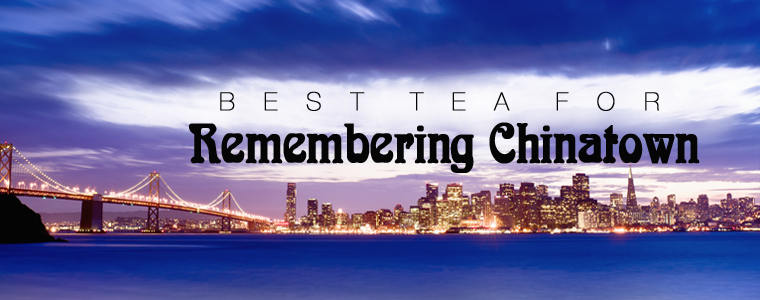Best Tea for Remembering Chinatown
by Abigail Beck
I’d forgotten about San Francisco’s hills. Not that I’d been to that golden city before, but from the movies I really should have remembered.
Evening was descending when we finally edged into a parking space at the intersection of Chestnut and Hyde — tilted up at a 30 degree angle. My family and I had two hours to hoof it down to Chinatown and find something interesting to do.
I tackled the climb with relish, thinking of the phenomenal workout that loomed before me. (I won’t deny that after a while, visions of Currahee from Band of Brothers did come to mind.)
Eventually we made it to Grant Street, the heart of Chinatown. Up ahead a black-lettered sign caught my attention: Free Tea Tasting. The yellowish light from inside invaded the darkening gray of the street.
My family humored me.
The shop was a long, narrow hall-like room with an amber wood bar stretching down the right side. Opposite stood the treasure chests: huge glass jars holding every kind of Asian tea imaginable, loose-leaf, colorful and mysterious. Blue tea. Jasmine Pearl. Water Fairy something-or-other.
A young Chinese woman behind the counter asked me if I needed any help. No, no just looking (stock answer). I tried to be inconspicuous as I watched a middle-aged Chinese man, possibly the owner, preparing tea samples for a man sitting at one of the bar stools. In a haphazard-seeming manner that I’d never seen before, he flipped the tea leaves in a shallow porcelain strainer over a white porcelain pot, sloshing some of it over the sides and down into a bamboo box tray that had a grating for a top (to catch the tea I imagine). The steeping took only seconds, and soon he poured the earthy colored brew into an eggshell-sized cup for the man to taste. As I stood there, the Chinese tea-maker finally turned his attention to me.
I asked him about Blue Tea. He said it was not tea but an herbal infusion, then moved on to another customer.
By this time my sister had joined me.
“Are you going to taste some?” she said.
Theoretically.
I tried again when the man came my way.
“What’s Water Fairy Tea?”
My ears weren’t ready for his accent, and all I heard was a flurry of syllables. Clueless, I replied: “What’s that?”
“Alfalfa.” My sister to the rescue with a timely translation. “It tastes like alfalfa.”
I certainly wasn’t getting very far with this line of questioning.
“Do you have any recommendations?” I said, thinking it would spark some kind of lively interaction. Wrong.
“What do you like?”
My vague shrug wasn’t an answer.
“I don’t know what you like, I don’t know what you need,” he said.
I must have looked uncomfortable. He tried to help me along.
“What kind of tea do you usually drink?”
“Black.”
“English or Asian?”
“English.”
He made a face. “With milk and sugar?”
“Yes.”
He shuddered. Out of a desire (I suspect) to reform my banal palate he began making a tea for me to taste, sloshing the brew over the edge of the pot into the bamboo tray.
It was yellow tea. The liquor I sipped from my own eggshell of a cup tasted rather bitter, and naturally it was a yellow-brown color. I made some kind of polite comment. Next he prepared an oolong. This one I liked better.
“I have one you’ll like,” he said.
Glad that we were on friendlier terms, I tasted an orangey third brew – it was sweeter, more fruity.
“Lychee Black,” he said.
Grown in the Guangdong province of China, this particular blend of tea gets its flavor from the fruit of the lychee (or lichee) tree, a tropical evergreen cultivated mainly in China and India. Resembling hybrid raspberry-chestnuts, the fruits contain a translucent white inner flesh that flavors many desserts, and in this case, tea. The tea itself takes only seconds to brew (about 20), and its leaves can be reused up to four times without replacement.
My dad took a sip of my sample and approved. He thought I should buy some, so I finally got the man’s attention again (poor guy, all he wanted was to close his shop – it was nearly 7 p.m.)
“How many kilos?”
My dad rescued me this time, as the sarcasm flew over my head. We’d take four ounces.
The man went out of his way to pack my tightly-wrapped gold and green foil package of Lychee in a neat little gift bag. I handed over my cash and he sent us off with a parting remark:
“No more drinking tea that comes in tea bags.”
“All right,” I laughed.
Of course I will go on drinking my cheap teas and tisanes, but a quality addition to my cabinet is always a treat – especially one that tells a story every time I spoon the leaves into my strainer.
Lychee Black
Can be purchased: in store or online
Website: www.vitaltealeaf.net
Cost: $12.00 for 4 oz. loose leaf (also available in kilos)
RedFence Rating: 8 (out of 10)








